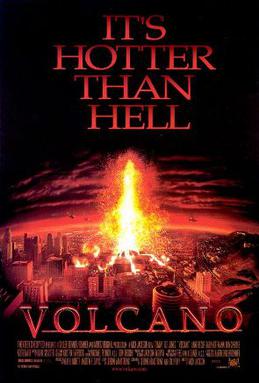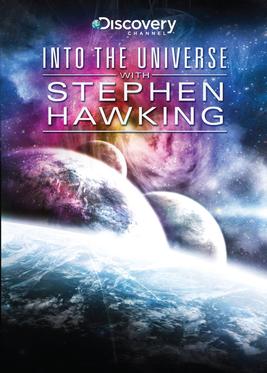Visual effects is the process by which imagery is created or manipulated outside the context of a live-action shot in filmmaking and video production. The integration of live-action footage and other live-action footage or CGI elements to create realistic imagery is called VFX.

Volcano is a 1997 American disaster film directed by Mick Jackson, written by Jerome Armstrong and Billy Ray, and produced by Neal H. Moritz and Andrew Z. Davis. The film stars Tommy Lee Jones, Anne Heche, Don Cheadle and Keith David. It tells the story of an effort to divert the path of a dangerous lava flow through the streets of Los Angeles following the formation of a volcano at the La Brea Tar Pits. The story was inspired by the 1943 formation of the Parícutin volcano in Mexico.
Spider-Man: The New Animated Series, or simply Spider-Man, is an American animated superhero television series based on the Marvel Comics character Spider-Man and produced by Sony Pictures Television. Initially intended to serve as a continuation of Sam Raimi's film Spider-Man (2002), as well as a loose adaptation of the Ultimate Spider-Man comic books by Brian Michael Bendis, the show was made using computer generated imagery (CGI) rendered in cel shading. It ran for only one season of 13 episodes, premiering on July 11, 2003, and was broadcast on cable channels MTV in the U.S. and YTV in Canada.

Walking with Monsters – Life Before Dinosaurs, marketed as Before the Dinosaurs – Walking with Monsters in North America, is a 2005 three-part nature documentary television miniseries created by Impossible Pictures and produced by the BBC Studios Science Unit, the Discovery Channel, ProSieben and France 3. Walking with Monsters explores life in the Paleozoic era, showcasing the early development of groups such as arthropods, fish, amphibians, reptiles and synapsids. Like its predecessors Walking with Dinosaurs (1999) and Walking with Beasts (2001), Walking with Monsters is narrated by Kenneth Branagh.

Biohazard 4D-Executer is a 2000 Japanese 3D animated biopunk horror film based on the Resident Evil series of survival horror video games. It was created by Capcom in cooperation with Visual Science Laboratory, and distributed by Digital Amuse. Biohazard 4D-Executer was directed by Koichi Ohata, and written by Daisuke Okamoto, who was supervised by the game series developers. A limited release, the 20-minute film has been an attraction in Japanese theme parks since November 2000, and can be seen in movie theaters and smaller booths.
Mikael Salomon is a Danish cinematographer, director and producer of film and television. After a long cinematography career in Danish cinema, he transitioned to the Hollywood film industry in the late 1980s, earning two Academy Award nominations. He is also a television director whose credits include dozens of series, films and miniseries including Band of Brothers, Salem's Lot, Rome, and The Andromeda Strain. His awards and nominations include a Primetime Emmy Award and a Directors Guild of America Award.

The Sidoarjo mud flow is the result of an erupting mud volcano in the subdistrict of Porong, Sidoarjo in East Java, Indonesia that has been in eruption since May 2006. It is the biggest mud volcano in the world; responsibility for the disaster was assigned to the blowout of a natural gas well drilled by PT Lapindo Brantas, although company officials contend it was caused by a very distant earthquake that occurred in a different province.
Secrets of the Dead, produced by WNET 13 New York, is an ongoing PBS television series which began in 2000. The show generally follows an investigator or team of investigators exploring what modern science can tell us about some of the great mysteries of history. Most programs incorporate primary source material, first-hand accounts, dramatic reenactments, and computer-generated imagery (CGI) to tell the story. The series originated in a series of the same name in the United Kingdom first shown by Channel 4 in 1999. The first two seasons for each country were broadly similar, but thereafter diverged. The US series includes some programs shown in other Channel 4 series. In the case of original British episodes, PBS re-edited, re-branded and finally re-narrated them with various American voice artists. PBS description: "Scientists seek to uncover celebrated mysteries of the past in this occasional British series."

"Gridlock" is the third episode of the third series of the British science fiction television series Doctor Who, which was first broadcast on BBC One on 14 April 2007. It was written by Russell T Davies and directed by Richard Clark.

Earth Revealed: Introductory Geology, originally titled Earth Revealed, is a 26-part video instructional series covering the processes and properties of the physical Earth, with particular attention given to the scientific theories underlying geological principles. The telecourse was produced by Intelecom and the Southern California Consortium, was funded by the Annenberg/CPB Project, and first aired on PBS in 1992 with the title Earth Revealed. All 26 episodes are hosted by Dr. James L. Sadd, professor of environmental science at Occidental College in Los Angeles, California.
Raging Planet is an American documentary television series that originally aired in 1997 and 2009 on the Discovery Channel. The program focuses on natural disasters. It currently airs periodically on the Science Channel.

Into the Universe with Stephen Hawking is a 2010 science documentary television mini-series written by British physicist Stephen Hawking. The series was created for Discovery Channel by Darlow Smithson Productions and features computer generated imagery of the universe created by Red Vision. The series premiered on 25 April 2010 in the United States and started on 9 May 2010 in the United Kingdom with a modified title, Stephen Hawking's Universe.
Xero Error, also known as Levity - Xero Error Minus1, is a computer generated science fiction film created and directed by Ashraf Ghori and starring Muhammad Ali Jamadar, Rhiannon Downie, Mouna Abbassy, Phat Mo, Nasser Chhipa, Nick Rego, Adnan Arif, and Aqeel Fikree. It was produced by Xpanse CGI. It is notable for being UAE's first CGI science fiction film. It was shown at the 63rd Cannes Film Festival.

How The Universe Works is a science documentary television series that provides scientific explanations about the inner workings of the universe and everything it encompasses. With the use of computer-generated imagery (CGI) and visual effects, each episode presents and narrates a topic about the universe, which then are complemented with scientific insights from leading scientists of organizations such as NASA and CERN.
The history of computer animation began as early as the 1940s and 1950s, when people began to experiment with computer graphics – most notably by John Whitney. It was only by the early 1960s when digital computers had become widely established, that new avenues for innovative computer graphics blossomed. Initially, uses were mainly for scientific, engineering and other research purposes, but artistic experimentation began to make its appearance by the mid-1960s – most notably by Dr. Thomas Calvert. By the mid-1970s, many such efforts were beginning to enter into public media. Much computer graphics at this time involved 2-D imagery, though increasingly as computer power improved, efforts to achieve 3-D realism became the emphasis. By the late 1980s, photo-realistic 3-D was beginning to appear in film movies, and by mid-1990s had developed to the point where 3-D animation could be used for entire feature film production.

Big, Bigger, Biggest is a British documentary television series which began airing in 2008. A total of 20 episodes have been produced across three series.

Computer-generated imagery (CGI) is a specific-technology or application of computer graphics for creating or improving images in art, printed media, simulators, videos and video games. These images are either static or dynamic. CGI both refers to 2D computer graphics and 3D computer graphics with the purpose of designing characters, virtual worlds, or scenes and special effects. The application of CGI for creating/improving animations is called computer animation, or CGI animation.
Triumph of the Vertebrates is a 2013 British documentary film by David Attenborough. It is about the evolution of vertebrates. The first part is From the Seas to the Skies, while the second is Dawn of the Mammals. The film uses a circular timetree of life generated by scientists S. Blair Hedges and Sudhir Kumar, from their TimeTree database, as a temporal framework for the production. The timetree was created using animated computer-generated imagery in scenes every 10 minutes during the 2-hour movie. The circular timetree was published by Hedges and Kumar in 2009 and Hedges was consulted during the production of the film.

The Reykjanes Peninsula in southwest Iceland is the continuation of the mostly submarine Reykjanes Ridge, a part of the Mid-Atlantic Ridge, on land and reaching from Esja in the north and Hengill in the east to Reykjanestá in the west. Suðurnes is an administrative unit covering part of Reykjanes Peninsula.

Strip the Cosmos is a documentary science television series narrated by Eric Loren. Aired by the Science Channel, it premiered on November 12, 2014.












